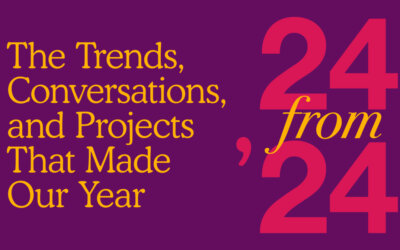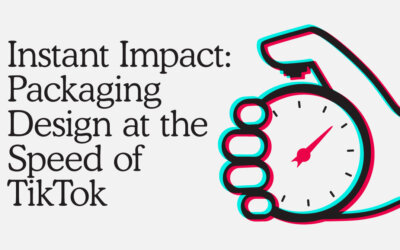Innovation Trends
Buckle Up!
We are entering a period of explosive innovation, get ready for the ride!

Liz Reese
Creative Director
June 3, 2022
If I could have traveled back in time when I was a young designer and told myself that in a few short years the projects that usually take months to finish would be completed in weeks, if not days, that instead of being faxed briefing documents from clients we would be sending files instantly over the internet, that we would have self-driving cars and mobile phones that double down as computers, she would have called me crazy!
Fast forward to 2022 where we’re still in the grips of a global pandemic and continuing to work remotely. As some industries buckled under the pressure, others found their feet by leveraging technology and the Cloud to stay connected. As for me, I also experienced something unique during lockdown: I invested in an Oculus Quest 2, a virtual reality (VR) headset. At first it was a novelty to help occupy some free time during the cold winter months in Chicago, but then I became hooked the moment I tried it on. I was awestruck by this immersive experience and the endless possibilities of what I could do and who I could meet despite being isolated in the house.
Aside from gaming and watching interactive documentaries where you could swim with sharks or be close to your favorite actors, the VR headset also allowed me to experience a rocket launch and a rover land on Mars with a community in a virtual cinema, albeit a room full of avatars! I met new people and connected with my friends abroad and niece in Scotland. These interactions with VR got me thinking: if the younger generation today are adopting this new wave of technology and, in some instances, have been forced to do so with remote schooling and virtual graduation ceremonies, brands (and the designers who support them) will also need to consider these new platforms to connect with their audiences and create brand experiences.
With many experts calling this era the “Fourth Industrial Revolution,” we are entering a period of explosive innovation with artificial intelligence (AI) and augmented reality (AR) that will shift how we work, play and interact with brands. Understandably, there is some bad PR and distrust associated with the digital revolution—we’ve all grown up with sci-fi films that depict a dystopian tech future such as Terminator, I-Robot and Her, to name a few—yet I do believe these advancements will be able to benefit people’s lives in the future while paving the way for new jobs.
It is important to note that AI and AR are not just around the corner, but rather, have already become part of everyday life. For example, early on Netflix leveraged AI to enhance our user experience by looking at our streaming data to provide personalized recommendations while building a stronger bond between the brand and the user. Furthermore, 71 million Americans regularly use an AI assistant such as Siri and Alexa to help automate and complete various tasks. Finally, retailers are embracing this technology such as online apparel retailer ASOS who introduced an AR tool called “See My Fit,” allowing consumers to view clothing on different sized models to help inform product selection and reduce returns.
Beyond the consumer experience, AI and AR have also established a foothold in the design world. For example, Nutella Unica jars were designed from a single algorithm that randomly generated millions of patterns and combinations of patterns. While I don’t believe this means we’ll be handing over the reins to computer generated design (and I sincerely hope not!), I do think these advancements in software will help inspire or guide us as we develop ideas.
Additionally, AR has been used to extend the brand experience beyond packaging. The wine brand 19 Crimes has introduced interactive labels that consumers can scan with their phones to hear more about the brand story and give each bottle its own personality. Consequently, the future of design means expanding our thinking beyond the 2-dimensional world of limited packaging space to help our clients tell stories that are more immersive, emotive and encompassing a broader sensorial experience.
No discussion on the future would be complete without mentioning sustainability. The environment is front and center as brands look at manufacturing capabilities, regenerative materials, and innovative approaches that don’t include chopping down entire forests in the process. One amazing example is the “Feel the Peel” orange juice bar produced by Italian studio Carlo Ratti Associati and energy company Eni. This juice bar allows consumers to watch the fruit being squeezed in front of their eyes and then drink from a bioplastic cup that’s 3D printed from the orange peel, thereby creating a sustainable and zero-waste experience from beginning to end. Over the coming years, brands will turn to agencies that can also help them develop and communicate design solutions that are also environmentally responsible.
While the provided examples are certainly innovative to me, we are just on the cusp of leveraging tech to its fullest potential. In fact, the global AR market is projected to grow from $6.12B in 2021 to $97.76B by 2028, which suggests we are just beginning to embrace the digital revolution. For many designers and the creative industry as a whole, this revolution can be both daunting and exciting with new opportunities to learn how to use different platforms and mediums to create brand experiences. Moreover, VR headsets may become the new work tool of the future that will enable us to collaborate more efficiently with clients all over the world. Lastly, clients will demand more of us in terms of sustainability, eCommerce and packaging that moves beyond the shelf. It’s not a matter of if but when this will happen. The design industry can no longer consider technological advancements as optional. Adopt early or get left behind—because there’s a whole new world about to unfold!
More Insights
24 from ’24
Curious about the biggest trends and moments that shaped 2024? From viral consumer habits to industry innovations, our year-in-review dives into the stories that kept us inspired—and what they mean for the future.
Packaging Design at the Speed of TikTok
TikTok is transforming how brands approach packaging design, with trends moving faster than ever. Discover how CPG brands can keep up with this rapid pace, capitalize on viral moments, and stay ahead in an ever-evolving consumer landscape.
From Pixels to Prototypes: The Role of Physical Design in a Digital Age
AI tools are transforming product and packaging design, offering efficiency and accessibility. However, they can’t replace the value of physical prototyping. Discover how we combine AI’s creativity with hands-on experimentation, ensuring our designs resonate with human experiences.


